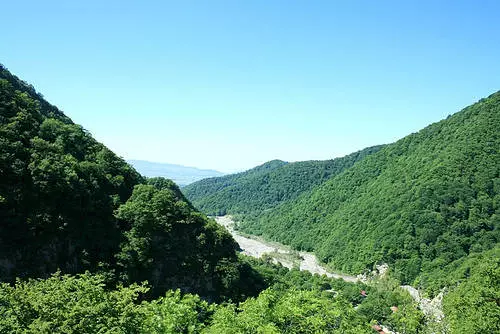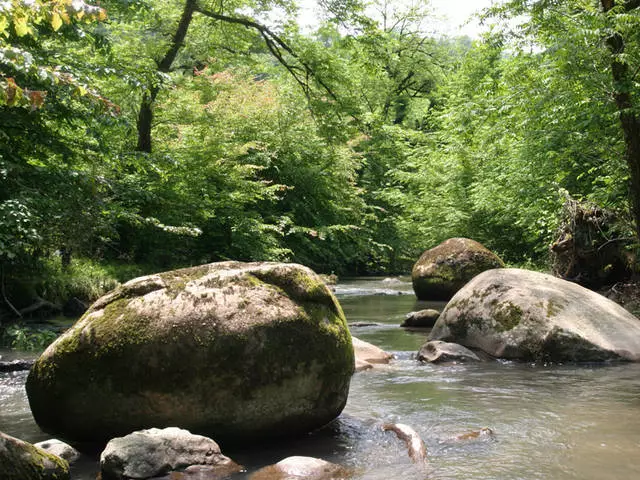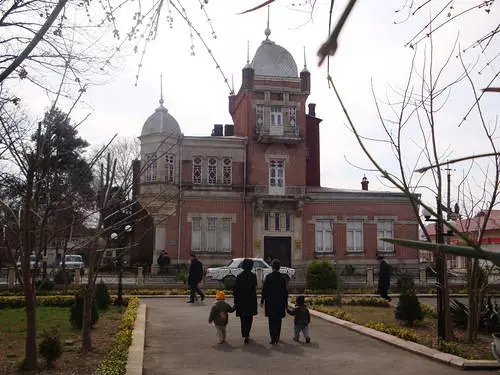The beautiful city of Lankan on the banks of the Caspian Sea is located almost border with Iran. This is a very old town, which was founded in the 10th century BC, but people lived on this territory from the Bronze Age, that is, from 3-2 millennia to our era. Trade has always been developed in the city - strong trading links for a long time existed with Iran, Turkey, Russia, states of Central Asia, China, India, etc. And nature is beautiful in Lankaran! The climate is in the area -Subtropropic, so, it is very nice there. And also, this is one of the best balneological resorts of the country, which people come from many countries, to correct a healthy.
And also, there is definitely there is something to see.
Hanega on the Pirsagat River
This medieval chanega is located near the city of Lankaran, on the banks of the Pirsagat River. Hanega is a complex of religious buildings - mosques, mausoleums. It is located on the caravan path from Shemakhi to Iran (Shemakhi City in Azerbaijan in the southeastern foothills of the Grand Caucasus in Azerbaijan in the southeastern foothills of the Big Caucasus 122 km west of Baku, well, remember, in the "Tale of the Golden Cockerel" the Shemakhan Queen). This honega is hidden by the fortress walls with turrets and braces. The construction is impressive with a magnificent finish, artistic carvings on stone, ceramic decorations. This design has developed in 12-14th centuries, but it is known that the design has repeatedly completed and rebuilt into the late centuries. The courtyard of the Hanegy has an irregular shape, and it is tightly built up. Here you can see the mosque (her carved Mihrab, that is, Niche in the wall of the mosque, is located today in the literary museum in Baku), Tip-Hussein's tomb (ceramic facing today are in the Hermitage and Museums Baku and Tbilisi) with Minaret (1256 years ). By the way, this hnega was (well, now it is destroyed by the order) so beautiful that the Mongols not only did not destroy the building, but even returned the stunned jewels back. Well, in 1318, the Goldenordin Khan Uzbek gave a luxurious gifts (gold, fur blood bars). Outside of the hanie, you can see the ruins of the caravansery (stable and shopping courtyard for caravans) with stone convices.
Mosque and tomb of Hussein's feast
This mosque and the tomb is included in the hahana, which I wrote above. The mosque is built of smooth stone slabs, blocked by a spherical dome. Mihrab with elegant carvings, cufic inscriptions (cufic letter - one of the oldest species of Arab letters) and ornament. The minaret is an octahedral trunk, with a platform located at the top of Muzzin (a minister of a mosque calling on Muslims on prayer). The mosque is connected to the tomb of a narrow dark pass. The tomb is lit by the rays of natural light through the window, the walls of it, as well as the tombstone in its center and the passage arch are decorated with ceramic facing with images of eight-beam stars (today it is not so well preserved). The main decoration of the tomb is the 11-meter tiles (the oressen is something like a tile, a tile) frieze, covered with gilding and patterns of dark blue and turquoise colors. These tiles are considered the best in the Middle East.
The tomb keeps the relics of the Saint Starta Pir Hussein, and this place is considered a shrine that is known far beyond the city.
Lenkoran Fortress
This structure was erected in about the 18th century. Once it was one of the most important fortresses of Talysh Khanate (the state that existed from 18 at the beginning of the 19th centuries in the southeastern part of Azerbaijan and on the eastern edge of the North-West Iran. The capital was the city of Lankaran). Today, only the ruins remained from the fortress, but when the fortress was simply frightened for opponents - high powerful walls of stone, teeth along the edges, moat around, which was filled with water during defensive necessity. All hostilities were held from two main towers in the north and south of the fortress - they, in fact, were located far from each other. However, in 1812, for example, the fortress fell under the onslaught of Russian troops. Inside the fortress, two bazaar - large and small, well, in each at the beginning of the last century were mosques, religious places of the city. Actually, these mosques exist so far.
Girkan National Park


This park was created in 2004 in the territory of the two regions of Azerbaijan: Lenkaranto and Astarinsky. The park is located on the ground with an area of about 43 hectares, and for the most part, it is thick forests. Many rare plants grow on the territory. In general, here you can see approximately 1900 species, including 162 endemic (that is, which grow exclusively in this area), 95 rare, 38 extinct species. There are also plants that are listed in the Red Book - Girkan Suskend, Iron Tree, Oak Cachet Testament, Inzir, Girkan Pear, Albia Lankaran (tree is), Persimmon Caucasian, Alder and others. The park is about 40 minutes from Lankaran.
House Mirakhmad Khana


There is a three-story building in the heart of the city. And this is one of the most luxurious Lankaran buildings. The house was erected in 1913 on the project of the French architect. However, the prognosis of national architecture is guessed in the architecture of the construction. By the way, this is the first in the city of a multi-storey building!
There are three tourist zones in Lankarani. The coastal area from the Caspian Sea with its luxurious beaches with black sand and pleasant to eyes with views and clean air. Another zone is-maplenic zone. Here you can find historical monuments, and recreation areas, such as the famous Lankaran sanatorium. In the forests of this area there are useful sources of "ob-su" ("hot water").
Narimanabad zone. The Narimanabad tourist area is mainly located on the Sarah Peninsula in the Caspian Sea, near the Iron and Highway Lankaran Baku, 17 km north of the district center. In the North-Gyzhagnja Reserve, in the south-east - sea, the city of Liman begins in the West. By the way, once Sarah was an island, but since 1956 it connects a dirt road with Liman and now is considered to be a peninsula.
